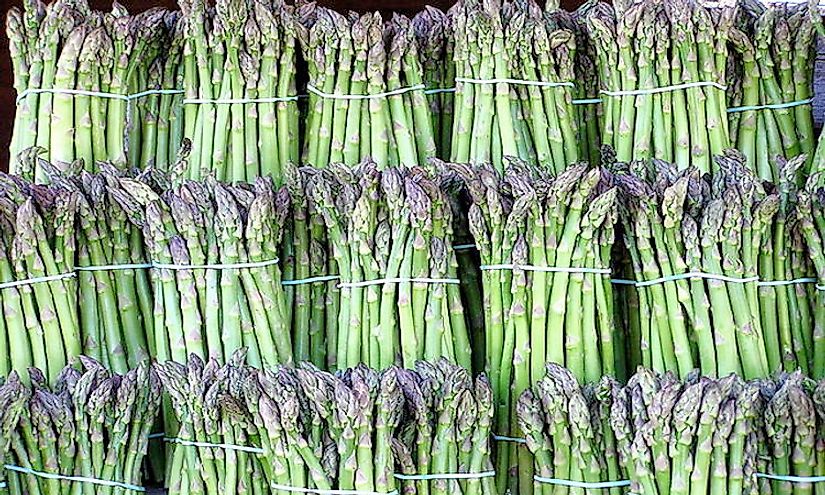Top Asparagus Producing Countries In The World

What Is Asparagus?
Asparagus is a flowering plant with at least 300 different species. Asparagus officinalis is a perennial plant, commonly used for human consumption. It appears in groups of 4 to 15 stalks that stand between 39 and 59 inches, each with small, scaly leaves. Asparagus is typically green in color, although there are also white and purple varieties. This plant is native to western Asia, northern Africa, and most of Europe.
Uses For Asparagus
Young asparagus stalks are eaten as a vegetable. This plant has been important to humans for thousands of years, used both for religious offerings and medicinal purposes. Recipes for asparagus dishes can be found in the oldest cookbook in existence, which dates back to the 3rd century AD. By the 15th century, it was grown by monks in France. Asparagus gradually made its way to England and Germany in the 1500’s. It became popular in the US in the mid-19th century. Today, asparagus is prepared in a variety of manners around the world from steamed to stir fried. Many places around the world have festivals to celebrate asparagus harvest time. It is an excellent source of vitamin B6, calcium, zinc, and magnesium.
Cultivation Of Asparagus
Asparagus grows well in soil with high salt content. Traditionally, salt has been added to asparagus planting areas to prevent weed growth. Unfortunately, this ruins the ground for other plants. A section of the root is planted during the winter, and by spring, the asparagus is ready for harvest. Some smaller cultivators plant asparagus with tomatoes because it is believed that the tomato repels a parasitic beetle. In turn, the asparagus protects the tomato by repelling a root parasite. The US, the EU, and Canada are the world’s top asparagus importers.
Top Asparagus Producing Countries
China
China takes the spot for the number 1 asparagus producing country in the world. It produces 7.35 million metric tons of asparagus every year. Of this, the country reports exporting only 4,553 metric tons. Some experts believe this production number is inflated given that the country only cultivated around 292,000 metric tons in 2014. Although asparagus production here has been increasing every year, a jump like this seems unlikely claim critics. Around 80% of this country’s total asparagus, harvest takes place in the following provinces: Shandong, Shanxi, Hebei, Henan, and Fujian. Additionally, more than half of the asparagus produced here is of the white variety.
Peru
The world’s second biggest asparagus producer is Peru with 376,645 metric tons. The US introduced this vegetable to Peru in the 1990’s as part of its War on Drugs campaign. The idea was that asparagus production would replace drug (particularly cocaine) production. The US government subsidized the asparagus industry here, which had a detrimental impact on American farmers and asparagus production. In fact, the US reduced its asparagus production area by 55% between California and Washington. Peru reports that the asparagus industry provides jobs to 50,000 individuals.
Mexico
Mexico is the third largest asparagus producer in the world. This country harvests 119,789 metric tons annually. Its production rate has been increasing on a yearly basis in an attempt to keep up with international demand. The Caborca region and Yaqui Valley are two of the strongest asparagus-producing areas. In fact, asparagus from the Caborca region is one of the biggest suppliers in the North American market.
Other top asparagus producing countries can be found in the chart published below.
Top Asparagus Producing Countries In The World
| Rank | Area | Production (Int $1000) | Production (Metric tons) |
|---|---|---|---|
| 1 | China, mainland | 6,689,690 | 7,350,000 |
| 2 | Peru | 342,807 | 376,645 |
| 3 | Mexico | 109,027 | 119,789 |
| 4 | Germany | 93,196 | 102,395 |
| 5 | Thailand | 59,160 | 65,000 |
| 6 | Spain | 41,321 | 45,400 |
| 7 | United States of America | 31,418 | 34,520 |
| 8 | Japan | 27,304 | 30,000 |
| 9 | Italy | 27,226 | 29,914 |
| 10 | France | 18,148 | 19,940 |







